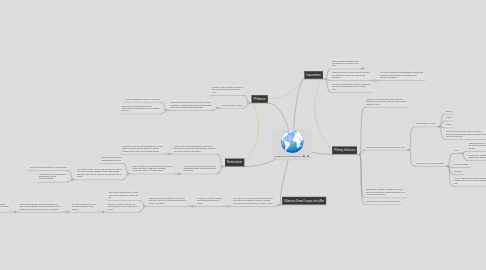
1. Militarism
1.1. A belief in the necessity of building and maintaining a strong military force
1.2. Early twentieth century
1.2.1. European nationalists build up military arsenals in order to compete with Britain(had the largest navy) and Russia(had the largest army
1.2.1.1. Led to a dangerous buildup of weapons
1.2.1.2. Advances in technology led to the development of more powerful and deadlier weapons
2. Nationalism
2.1. Nationalists in general arepeople who place a high priority on promoting the identity, interests, and culture of their own nation;
2.1.1. in Canada in the early twentieth century, a term used to describe people who put Canada’s interests above those of the British Empire
2.2. Led to some Europeans to want to be united with others of the same ethnic background
2.2.1. Austria-Hungary, for example. was home to 50 million Austrians, Hungarians, Bosnians, Ukrainians, Serbs , and other groups
2.2.1.1. Many wanted their own independent countries
2.2.1.2. Many Serbs living in Bosnia and Herzegovina, which was part of Austria-Hungary at this time, wanted liberation from Austrian control and became part of Serbia
2.2.1.2.1. Many Serbian nationalists in Serbia agreed
2.2.1.2.2. At the same time, Serbia feared being taken over by Austria-Hungary
3. Alliances Draw Europe into War
3.1. June 28, 1914 a radical Serbian nationalist shot and killed the Archduke of Austria-Hungary, Franz Ferdinand, and his wife, Duchess Sophia
3.1.1. In response, Austria-Hungary made several demands of Serbia
3.1.1.1. When Serbia did not agree to meet all the demands, Austria-Hungary declared war on Serbia on August 1
3.1.1.1.1. Due to the military alliance, Russia came to the defence of Serbia, its ally
3.1.1.1.2. Germany, Austria-Hungary's ally, declared war on Russia and then on Frnace
4. Imperialism
4.1. Britain's empire stretched over one quarter of the globe's land mass
4.1.1. Custom forms
4.2. Other European countries such as Germany also wanted to control more lands and resources
4.2.1. Animosity between nations(especially Britain and Germany) grew strong as competition for territory increased
4.3. A policy of extending a country's power and influence through diplomacy or military force
5. Military alliances
5.1. Members of a military alliance promise one another mutual military support if attacked by another country
5.2. Two major military alliances in Europe in 1914
5.2.1. Triple Entente, or Allies
5.2.1.1. Britain
5.2.1.2. Russia
5.2.1.3. France
5.2.1.4. Some neutral countries such as Portugal, Belgium, Romania and Greece joined the Entente side later in the war
5.2.2. Triple Alliance, or Central Powers
5.2.2.1. Italy
5.2.2.1.1. Original member of the Triple Alliance, but did not ally with them when the fighing started
5.2.2.1.2. In April 1915, changed its allegiance to the Triple Entente
5.2.2.2. Austria-Hungary
5.2.2.3. Germany
5.2.2.4. Some neutral countries such as Turkey and Bulgaria joined the Alliance side later in the war
